The Nexus between Study Burnout Profiles and Social Support —The Differences between Domestic (Finnish) and International Master’s Degree Students
Abstract
1. Introduction
1.1. Study Burnout among HE Students and Comparing Domestic and International Students
1.2. Social Support as a Buffer for Study Burnout
2. Aims of the Study
- RQ1.
- What study burnout risk profiles can be identified among 1st year master’s students?
- RQ2.
- Are the varied study burnout risk profiles related to study success (grades and study credits)? Do the international and the domestic students differ from each other in this regard?
- RQ3.
- What support needs did the students report?
- RQ4.
- Are there differences in reported needs for support between the students having different profiles of burnout risk? How do international cf. domestic students differ from each other in this regard?
3. Materials and Methods
3.1. Research Context
3.2. Participants
3.3. Study Design
3.3.1. Measures
3.3.2. Statistical Analysis
3.3.3. Qualitative Analysis
4. Results
4.1. Determining the Latent Study Burnout Risk Profiles
4.2. The Study Burnout Risk Profiles
4.3. Study Success and Study Burnout Risk Profiles: Comparing Domestic and International Students
4.4. The Social Support Needed: Forms and Sources
“I feel like X offers a very wide range of services, because I keep hearing about new things from students around me, but sometimes I’m just not quite sure where to find them or what they even are, so being informed of them more would be great.” (I_3134)
“Finding interesting courses is a challenge. The database is full of similar names to which the same jargon has been copied. Only information from older students through a bush radio tells you what’s going on.” (D_168)
“Teachers seem too busy and you don’t get proper feedback from them.” (D_174)
“I think pedagogy could be improved. It would be good to teach things by repeating the basics. Sometimes it feels like the courses rely too much on the teachings of the previous course. This could be improved, for example, by providing a review of the necessary basic issues as additional material. In lectures, new things seem to come up exponentially, so it would be good to repeat previous lectures of the same course (even in a few sentences). And connects lecture issues with (practical) examples.” (D_121)
“[…] I’m limited in the choice of courses as I don’t have much time as other students who are free to study up to 4 years. Besides, if I want to devote a whole year for my thesis writing like other EU students, I have to finish all of my courses from the first year, which is impossible. […]” (I_1000)
“To plan better the amount of work in each course considering all the courses that we have to take each period in a mandatory way.” (I_ 3367)
“I really appreciate having video recordings of lectures in order to have more options on dealing with the pressure of continuous deadlines.” (I_ 3577)
“An idea: The definition of a credit could be changed, as 15 ECTS/period means a rather inhumane working week. Another option is to stretch the periods. On the one hand, it is good that students are required to work hard and learn, but on the other hand, it does not make sense for so many to take much more than 5 years to complete their studies.” (D_ 3639)
“We had issues with professor before that also who wasn’t capable enough to listen and have the time and willingness to answer as well. We filed complaint even but nothing changed […]” (I_1324)
“In general, some mandatory one-on-one well-being consulting can be useful. In my case, I would probably not go to a consultation meeting voluntarily.” (I_3224)
“In group work, competence remains one-sided and often insufficient background support from the course organizers leads to a loss of motivation for the whole group. […]. Learning also often plays a side role in group work, as usually the areas of responsibility are divided according to previous competence, so it is not possible to develop competence in other subject areas.” (D_3438)
4.5. Forms of Social Support Needed and Study-Related Burnout Risk Profiles
4.6. Forms of Social Support Needed and Study-Related Burnout Risk Profiles: Comparing Finnish and International Students
5. Discussion
5.1. Implications for Developing Higher Education in Finland
5.2. Limitations of the Study and Future Research
Author Contributions
Funding
Informed Consent Statement
Data Availability Statement
Conflicts of Interest
Appendix A
| Exhaustion | Cynicism | Inadequacy |
|---|---|---|
| 1. I feel overwhelmed by the work related to my studies 2. I often sleep badly because of matters related to my studies 3. During my free time I worry over matters related to my studies 4. The pressure of my studies causes problems in my close relationships with others | 1. I feel a lack of study motivation and often think of giving up 2. I feel that I am losing interest in my studies 3. I am continually wondering whether my studies have any meaning | 1. I often have feelings of inadequacy in my studies 2. I used to expect I would achieve much more in my studies than I expect now |
References
- Salmela-Aro, K.; Read, S. Study engagement and burnout profiles among Finnish higher education students. Burn. Res. 2017, 7, 21–28. [Google Scholar] [CrossRef]
- Salmela-Aro, K.; Tolvanen, A.; Nurmi, J.-E. Social strategies during university studies predict early career work burnout and engagement: 18-year longitudinal study. J. Vocat. Behav. 2011, 79, 145–157. [Google Scholar] [CrossRef]
- Salmela-Aro, K.; Kiuru, N.; Leskinen, E.; Nurmi, J.-E. School Burnout Inventory (SBI): Reliability and validity. Eur. J. Psychol. Assess. 2009, 25, 48–57. [Google Scholar] [CrossRef]
- Salmela-Aro, K.; Savolainen, H.; Holopainen, L. Depressive symptoms and school burnout during adolescence: Evidence from two cross-lagged longitudinal studies. J. Youth Adolesc. 2009, 38, 1316–1327. [Google Scholar] [CrossRef] [PubMed]
- Lin, S.-H.; Huang, Y.-C. Life stress and academic burnout. Act. Learn. High. Educ. 2014, 15, 77–90. [Google Scholar] [CrossRef]
- Taris, T.W. Is there a relationship between burnout and objective performance? A critical review of 16 studies. Work. Stress 2006, 20, 316–334. [Google Scholar] [CrossRef]
- Madigan, D.; Curran, T. Does Burnout Affect Academic Achievement? A Meta-Analysis of Over 100,000 Students. Educ. Psychol. Rev. 2021, 33, 387–405. [Google Scholar] [CrossRef]
- Dyrbye, L.N.; Thomas, M.R.; Power, D.V.; Durning, S.; Moutier, C.; Massie, F.S., Jr.; Harper, W.; Eacker, A.; Szydlo, D.W.; Sloan, J.A.; et al. Burnout and serious thoughts of dropping out of medical school: A multi-institutional study. Acad. Med. 2010, 85, 94–102. [Google Scholar] [CrossRef]
- Räisänen, M.; Postareff, L.; Lindblom-Ylänne, S. Students’ experiences of study-related exhaustion, regulation of learning, peer learning and peer support during university studies. Eur. J. Psychol. Educ. 2021, 36, 1135–1157. [Google Scholar] [CrossRef]
- Kunttu, K.; Pesonen, T.; Saari, J. Student Health Survey 2016: A National Survey among Finnish University Students; Finnish Student Health Service: Helsinki, Finland, 2016. [Google Scholar]
- UNESCO. Nurturing the Social and Emotional Wellbeing of Children and Young People during Crises; UNESCO: Paris, France, 2020. [Google Scholar]
- Holzer, J.; Lüftenegger, M.; Korlat, S.; Pelikan, E.; Salmela-Aro, K.; Spiel, C.; Schober, B. Higher Education in Times of COVID-19: University Students’ Basic Need Satisfaction, Self-Regulated Learning, and Well-Being. AERA Open 2021, 7, 23328584211003164. [Google Scholar] [CrossRef]
- Oliveira Carvalho, P.; Hülsdünker, T.; Carson, F. The Impact of the COVID-19 Lockdown on European Students&rsquo’ Negative Emotional Symptoms: A Systematic Review and Meta-Analysis. Behav. Sci. 2022, 12, 3. [Google Scholar] [CrossRef] [PubMed]
- Virtanen, V.; Pyhalto, K. What Engages Doctoral Students in Biosciences in Doctoral Studies? Psychology 2012, 3, 1231–1237. [Google Scholar] [CrossRef]
- Väisänen, S.; Pietarinen, J.; Pyhältö, K.; Toom, A.; Soini, T. Social support as a contributor to student teachers’ experienced well-being. Res. Pap. Educ. 2017, 32, 41–55. [Google Scholar] [CrossRef]
- Kim, B.; Jee, S.; Lee, J.; An, S.; Lee, S.M. Relationships between social support and student burnout: A meta-analytic approach. Stress Health 2018, 34, 127–134. [Google Scholar] [CrossRef]
- Kiema-Junes, H.; Hintsanen, M.; Soini, H.; Pyhältö, K. The role of social skills in burnout and engagement among university students. Electron. J. Res. Educ. Psychol. 2020, 18, 77–100. [Google Scholar] [CrossRef]
- Väisänen, S.; Pietarinen, J.; Pyhältö, K.; Toom, A.; Soini, T. Student teachers’ proactive strategies for avoiding study-related burnout during teacher education. Eur. J. Teach. Educ. 2018, 41, 301–317. [Google Scholar] [CrossRef]
- Freudenberger, H.J. Staff Burn-Out. J. Soc. Issues 1974, 30, 159–165. [Google Scholar] [CrossRef]
- Maslach, C.; Jackson, S.E. The measurement of experienced burnout. J. Organ. Behav. 1981, 2, 99–113. [Google Scholar] [CrossRef]
- Schaufeli, W.B.; Martínez, I.M.; Pinto, A.M.; Salanova, M.; Bakker, A.B. Burnout and Engagement in University Students. J. Cross-Cult. Psychol. 2002, 33, 464–481. [Google Scholar] [CrossRef]
- Maslach, C.; Schaufeli, W.B.; Leiter, M.P. Job Burnout. Annu. Rev. Psychol. 2001, 52, 397–422. [Google Scholar] [CrossRef]
- Maslach, C.; Leiter, M.P. Understanding the burnout experience: Recent research and its implications for psychiatry. World Psychiatry 2016, 15, 103–111. [Google Scholar] [CrossRef] [PubMed]
- Bergman, L.R.; Lundh, L.G. Introduction: The person-oriented approach: Roots and roads to the future. J. Pers. Oriented Res. 2015, 1, 1–6. [Google Scholar] [CrossRef]
- Pyhältö, K.; Pietarinen, J.; Haverinen, K.; Tikkanen, L.; Soini, T. Teacher burnout profiles and proactive strategies. Eur. J. Psychol. Educ. 2021, 36, 219–242. [Google Scholar] [CrossRef]
- Meyer, J.P.; Stanley, L.J.; Vandenberg, R.J. A person-centered approach to the study of commitment. Hum. Resour. Manag. Rev. 2013, 23, 190–202. [Google Scholar] [CrossRef]
- Mäkikangas, A.; Kinnunen, U. The person-oriented approach to burnout: A systematic review. Burn. Res. 2016, 3, 11–23. [Google Scholar] [CrossRef]
- Woo, S.E.; Jebb, A.T.; Tay, L.; Parrigon, S. Putting the “Person” in the Center: Review and Synthesis of Person-Centered Approaches and Methods in Organizational Science. Organ. Res. Methods 2018, 21, 814–845. [Google Scholar] [CrossRef]
- Bergman, L.R.; Magnusson, D.; El Khouri, B.M. Studying Individual Development in An Interindividual Context: A Person-Oriented Approach; Psychology Press: London, UK, 2003; Volume 4. [Google Scholar]
- Laursen, B.; Hoff, E. Person-centered and variable-centered approaches to longitudinal data. Merrill-Palmer Q. 2006, 52, 377–389. [Google Scholar] [CrossRef]
- Fiorilli, C.; De Stasio, S.; Di Chiacchio, C.; Pepe, A.; Salmela-Aro, K. School burnout, depressive symptoms and engagement: Their combined effect on student achievement. Int. J. Educ. Res. 2017, 84, 1–12. [Google Scholar] [CrossRef]
- Tuominen-Soini, H.; Salmela-Aro, K. Schoolwork engagement and burnout among finnish high school students and young adults: Profiles, progressions, and educational outcomes. Dev. Psychol. 2014, 50, 649–662. [Google Scholar] [CrossRef]
- Portoghese, I.; Leiter, M.; Maslach, C.; Galletta, M.; Porru, F.; d’Aloja, E.; Finco, G.; Campagna, M. Measuring Burnout Among University Students: Factorial Validity, Invariance, and Latent Profiles of the Italian Version of the Maslach Burnout Inventory Student Survey (MBI-SS). Front. Psychol. 2018, 9, 2105. [Google Scholar] [CrossRef]
- Henning, M.; Krägeloh, C.; Moir, F.; Doherty, I.; Hawken, S. Quality of life: International and domestic students studying medicine in New Zealand. Perspect. Med Educ. 2012, 1, 129–142. [Google Scholar] [CrossRef] [PubMed][Green Version]
- Haverila, M.J.; Haverila, K.; McLaughlin, C. Variables affecting the retention intentions of students in higher education institutions: A comparison between international and domestic students. J. Int. Stud. 2020, 10, 358–382. [Google Scholar] [CrossRef]
- Kamardeen, I.; Sunindijo, R.Y. Stressors Impacting the Performance of Graduate Construction Students: Comparison of Domestic and International Students. J. Prof. Issues Eng. Educ. Pract. 2018, 144, 04018011. [Google Scholar] [CrossRef]
- Sakurai, Y.; Parpala, A.; Pyhältö, K.; Lindblom-Ylänne, S. Engagement in learning: A comparison between Asian and European international university students. Null 2016, 46, 24–47. [Google Scholar] [CrossRef]
- Pyhältö, K.; Peltonen, J.; Rautio, P. Summary Report on Doctoral Experience in the UniOGS Graduate School at the University of Oulu. 2016. Available online: http://jultika.oulu.fi/files/isbn9789526210841.pdf (accessed on 15 October 2021).
- Cobb, S. Social support as a moderator of lide stress. Psychosom. Med. 1976, 38, 300–314. [Google Scholar] [CrossRef]
- House, J. Work Stress and Social Support; Addison-Wesley Publishing Company: Boston, MA, USA, 1981. [Google Scholar]
- House, J.S.; Kahn, R.L.; McLeod, J.D.; Williams, D. Measures and Concepts of Social Support; Social Support and Health; Cohen, S., Syme, S.L., Eds.; Academic Press: Cambridge, MA, USA, 1985; pp. 83–108. [Google Scholar]
- Macdonald, G. Development of a social support scale: An evaluation of psychometric properties. Res. Soc. Work. Pract. 1998, 8, 564–576. [Google Scholar] [CrossRef]
- Dupont, S.; Galand, B.; Nils, F. The impact of different sources of social support on academic performance: Intervening factors and mediated pathways in the case of master’s thesis. Eur. Rev. Appl. Psychol. 2015, 65, 227–237. [Google Scholar] [CrossRef]
- Vekkaila, J.; Virtanen, V.; Taina, J.; Pyhältö, K. The function of social support in engaging and disengaging experiences among post PhD researchers in STEM disciplines. Stud. High. Educ. 2018, 43, 1439–1453. [Google Scholar] [CrossRef]
- Cohen, S.; Gottlieb, B.H.; Underwood, L.G. Social relationships and health. In Social Support Measurement and Intervention: A Guide for Health and Social Scientists; Oxford University Press: New York, NY, USA, 2000; pp. 3–25. [Google Scholar]
- Jacobs, S.R.; Dodd, D.K. Student Burnout as a Function of Personality, Social Support, and Workload. J. Coll. Stud. Dev. 2003, 44, 291–303. [Google Scholar] [CrossRef]
- Salami, S. Job Stress and Burnout among Lecturers: Personality and Social Support as Moderators. Asian Soc. Sci. 2011, 7, 110. [Google Scholar] [CrossRef]
- Yang, H.-J.; Farn, C.K. An investigation the factors affecting MIS student burnout in technical-vocational college. Comput. Hum. Behav. 2005, 21, 917–932. [Google Scholar] [CrossRef]
- Bhochhibhoya, A.; Dong, Y.; Branscum, P. Sources of Social Support Among International College Students in the United States. J. Int. Stud. 2017, 7, 671–686. [Google Scholar] [CrossRef]
- Cornér, S.; Löfström, E.; Pyhältö, K. The Relationships between Doctoral Students’ Perceptions of Supervision and Burnout. Int. J. Dr. Stud. 2017, 12, 91–106. [Google Scholar] [CrossRef]
- Romano, L.; Tang, X.; Hietajärvi, L.; Salmela-Aro, K.; Fiorilli, C. Students’ Trait Emotional Intelligence and Perceived Teacher Emotional Support in Preventing Burnout: The Moderating Role of Academic Anxiety. Int. J. Environ. Res. Public Health 2020, 17, 4771. [Google Scholar] [CrossRef] [PubMed]
- Peltonen, J.; Vekkaila, J.; Rautio, P.; Haverinen, K.; Pyhältö, K. Doctoral Students’ Social Support Profiles and Their Relationship to Burnout, Drop-Out Intentions, and Time to Candidacy. Int. J. Dr. Stud. 2017, 12, 157–173. [Google Scholar] [CrossRef]
- Creswell, J.; Plano Clark, V. Designing and Conducting Mixed Methods Research, 3rd ed.; SAGE: Thousand Oaks, CA, USA, 2018. [Google Scholar]
- Fetters, M.D.; Curry, L.A.; Creswell, J.W. Achieving integration in mixed methods designs-principles and practices. Health Serv. Res. 2013, 48, 2134–2156. [Google Scholar] [CrossRef] [PubMed]
- Parpala, A.; Lindblom-Ylänne, S. Using a research instrument for developing quality at the university. Qual. High. Educ. 2012, 18, 313–328. [Google Scholar] [CrossRef]
- Salmela-Aro, K.; Nurmi, J.E. Employees’ motivational orientation and well-being at work: A person-oriented approach. J. Organ. Chang. Manag. 2004, 17, 471–489. [Google Scholar] [CrossRef]
- Scrucca, L.; Fop, M.; Murphy, T.B.; Raftery, A.E. mclust 5: Clustering, Classification and Density Estimation Using Gaussian Finite Mixture Models. R. J. 2016, 8, 289–317. [Google Scholar] [CrossRef]
- Larose, C.; Harel, O.; Kordas, K.; Dey, D.K. Latent class analysis of incomplete data via an entropy-based criterion. Stat. Methodol. 2016, 32, 107–121. [Google Scholar] [CrossRef]
- Peng, Y.; Zhang, Y.; Kou, G.; Shi, Y. A multicriteria decision making approach for estimating the number of clusters in a data set. PLoS ONE 2012, 7, e41713. [Google Scholar] [CrossRef] [PubMed]
- Saaty, T. Decision making with the Analytic Hierarchy Process. Int. J. Serv. Sci. 2008, 1, 83–98. [Google Scholar] [CrossRef]
- Akogul, S.; Erisoglu, M. An Approach for Determining the Number of Clusters in a Model-Based Cluster Analysis. Entropy 2017, 19, 452. [Google Scholar] [CrossRef]
- Olejnik, S.F.; Algina, J. Generalized Eta and Omega Squared Statistics: Measures of Effect Size for Some Common Research Designs. Psychol. Methods 2004, 8, 434–447. [Google Scholar] [CrossRef]
- Bilder, C.R.; Loughin, T.M.; Nettleton, D. Multiple Marginal Independence Testing for Pick Any/C Variables. Commun. Stat. Simul. Comput. 2000, 29, 1285–1316. [Google Scholar] [CrossRef]
- Koziol, N.A.; Bilder, C.R. MRCV: A package for analyzing categorical variables with multiple response options. R J. 2014, 6, 144–150. [Google Scholar] [CrossRef]
- Marshall, C.; Rossman, G.B. Designing Qualitative Research, 5th ed.; Sage Publications: Thousand Oaks, CA, USA, 2011. [Google Scholar]
- Miles, M.B.; Huberman, A.M.; Saldaña, J. Qualitative Data Analysis: A Methods Sourcebook; SAGE: Thousand Oaks, CA, USA, 2014. [Google Scholar]
- Pyhältö, K. Function of supervisory and researcher community support in PhD and post- PhD trajectories. In Studies into Higher Education. Spaces, Journeys and New Horizons for Postgraduate Supervision; Bizer, E., Frick, L., Fourie-Malherbe, M., Pyhältö, K., Eds.; Sun Press: Stellenbosch, South Africa, 2018; pp. 205–222. [Google Scholar]
- Cornér, S.; Pyhältö, K.; Peltonen, J.; Bengtsen, S.S.E. Similar or different?: Researcher community and supervisory support experiences among Danish and Finnish social sciences and humanities PhD students. Stud. Grad. Postdr. Educ. 2018, 9, 274–295. [Google Scholar] [CrossRef]
- Lee, J.; Puig, A.; Kim, Y.B.; Shin, H.; Lee, J.H.; Lee, S.M. Academic Burnout Profiles in Korean Adolescents. Stress Health 2010, 26, 404–416. [Google Scholar] [CrossRef]
- Salmela-Aro, K.; Upadyaya, K. School engagement and school burnout profiles during high school–The role of socio-emotional skills. Eur. J. Dev. Psychol. 2020. [Google Scholar] [CrossRef]
- Chue, K.L.; Nie, Y. International Students’ Motivation and Learning Approach: A Comparison with Local Students. J. Int. Stud. 2016, 6, 678–699. [Google Scholar] [CrossRef]
- Wilcox, P.; Winn, S. ‘It was nothing to do with the university, it was just the people’: The role of social support in the first-year experience of higher education. Stud. High. Educ. 2005, 30, 707–722. [Google Scholar] [CrossRef]
- Hendrickson, B.; Rosen, D.; Aune, R.K. An analysis of friendship networks, social connectedness, homesickness, and satisfaction levels of international students. Int. J. Intercult. Relat. 2011, 35, 281–295. [Google Scholar] [CrossRef]
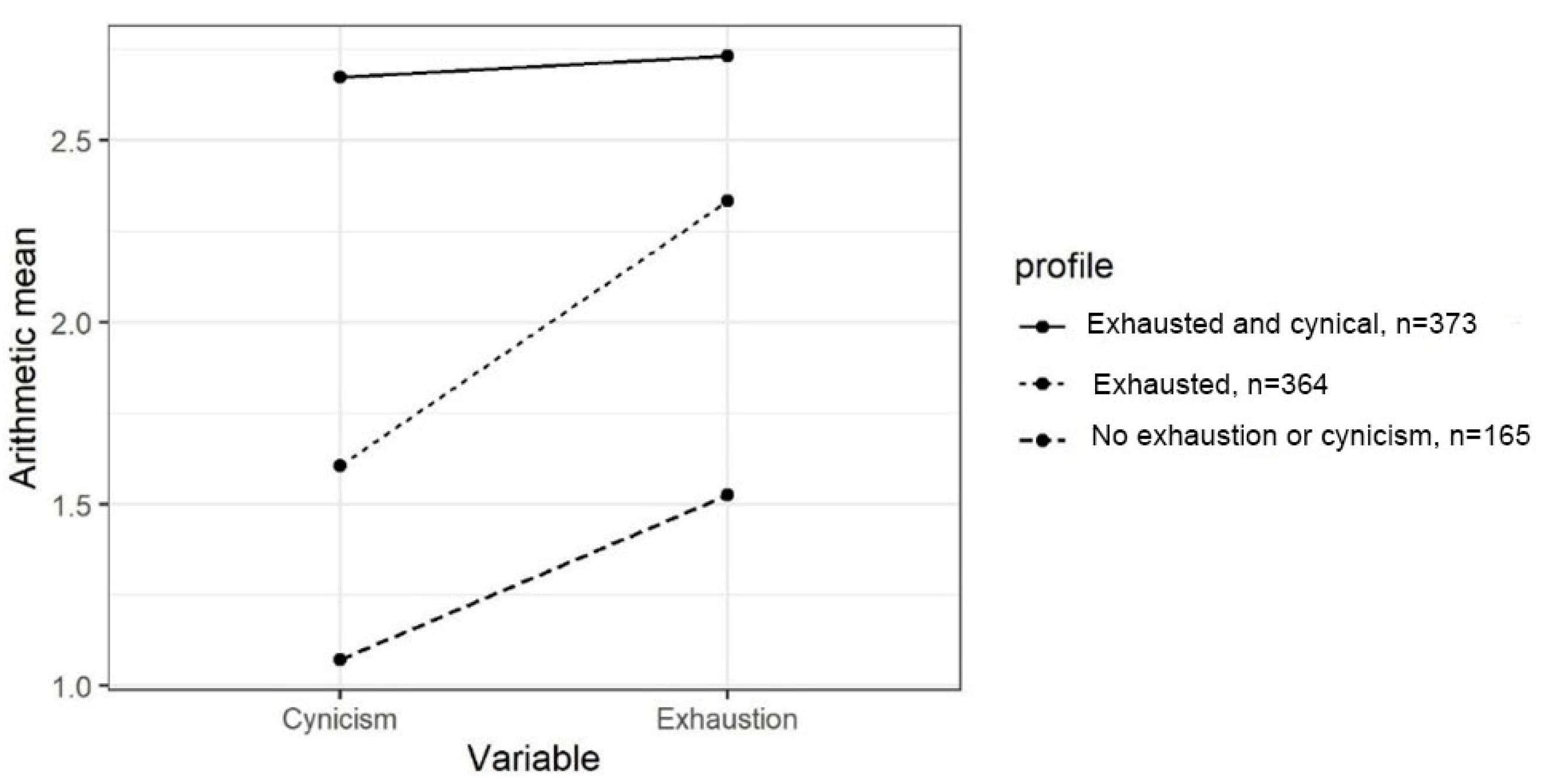
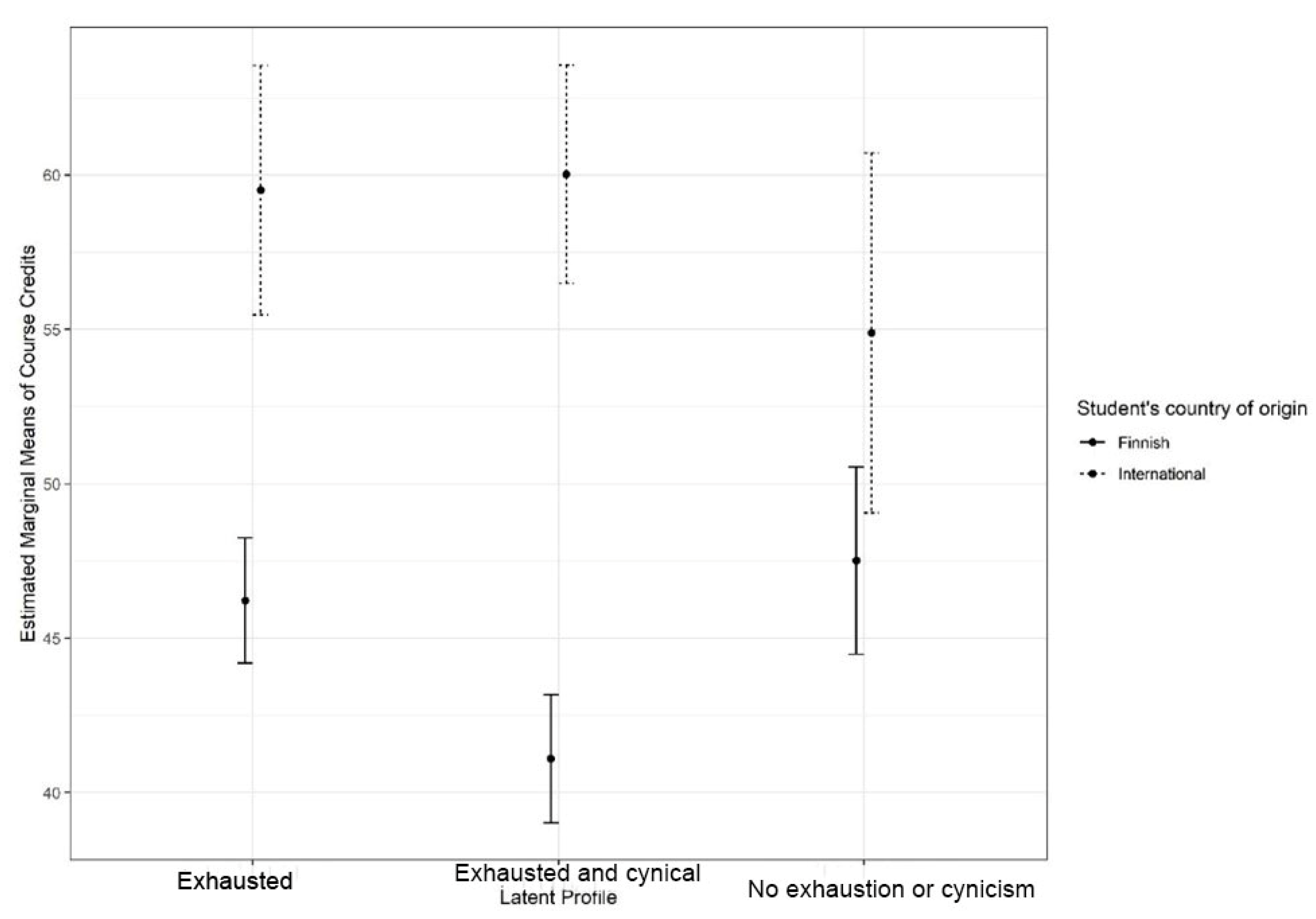
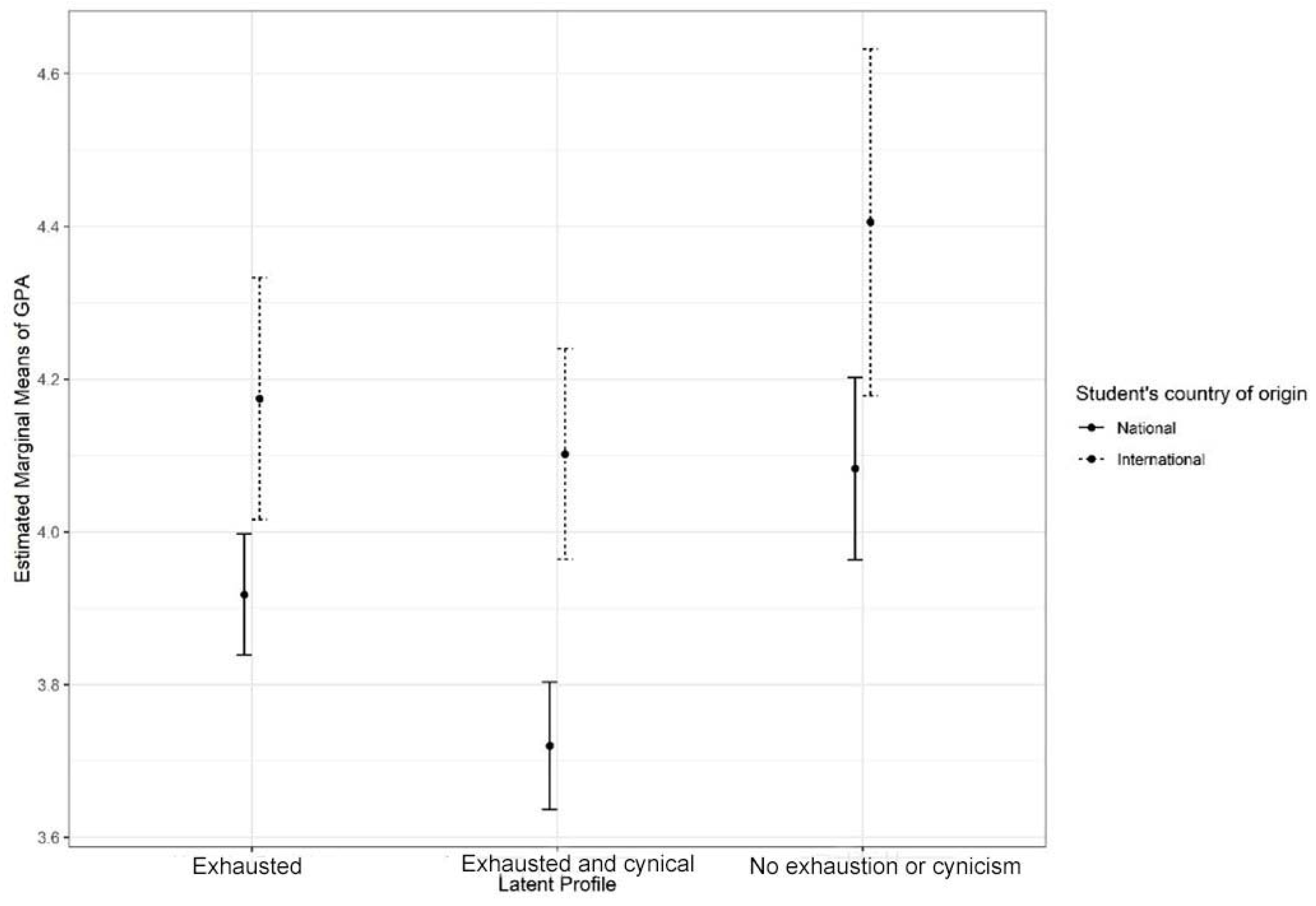
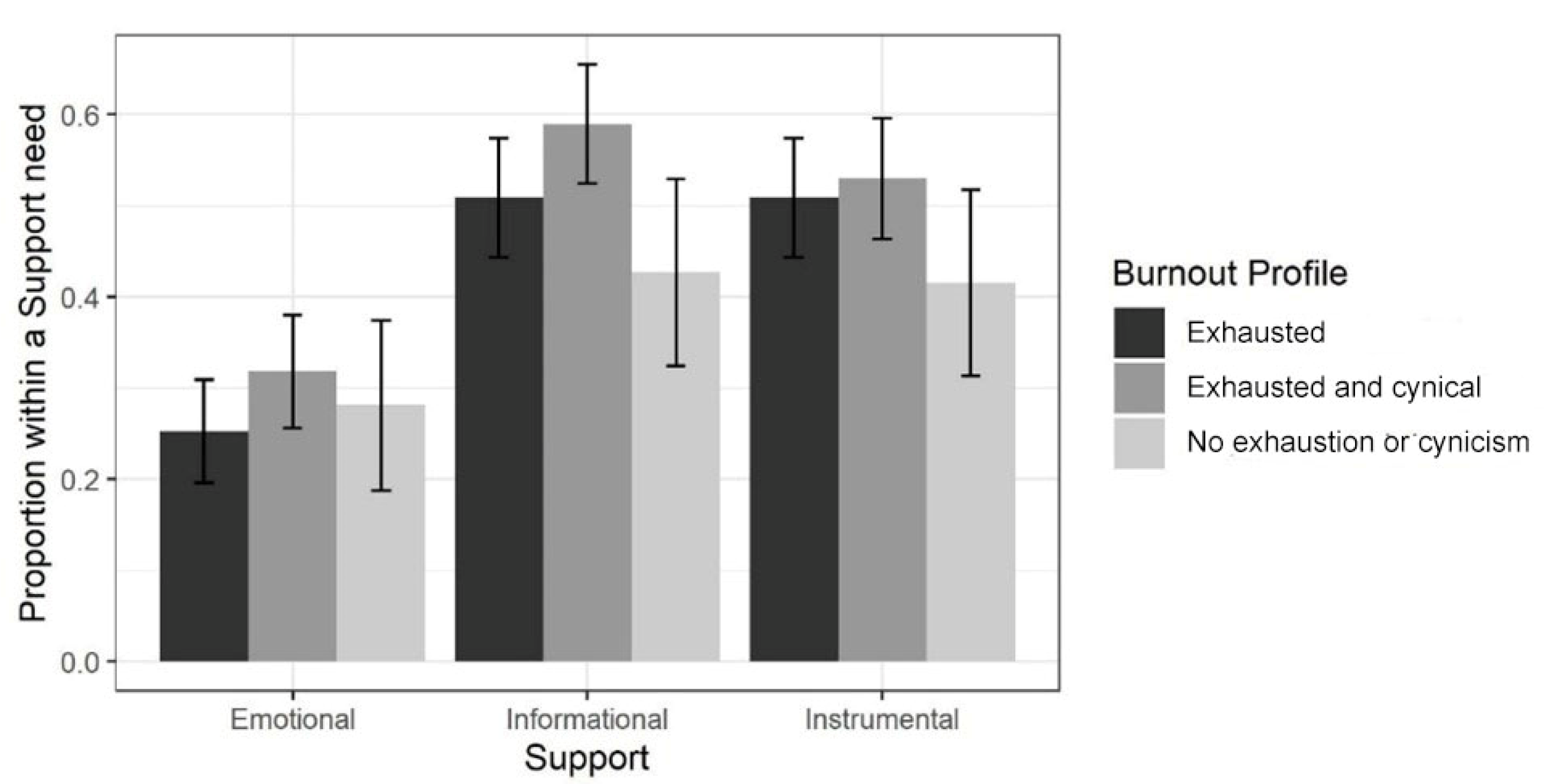
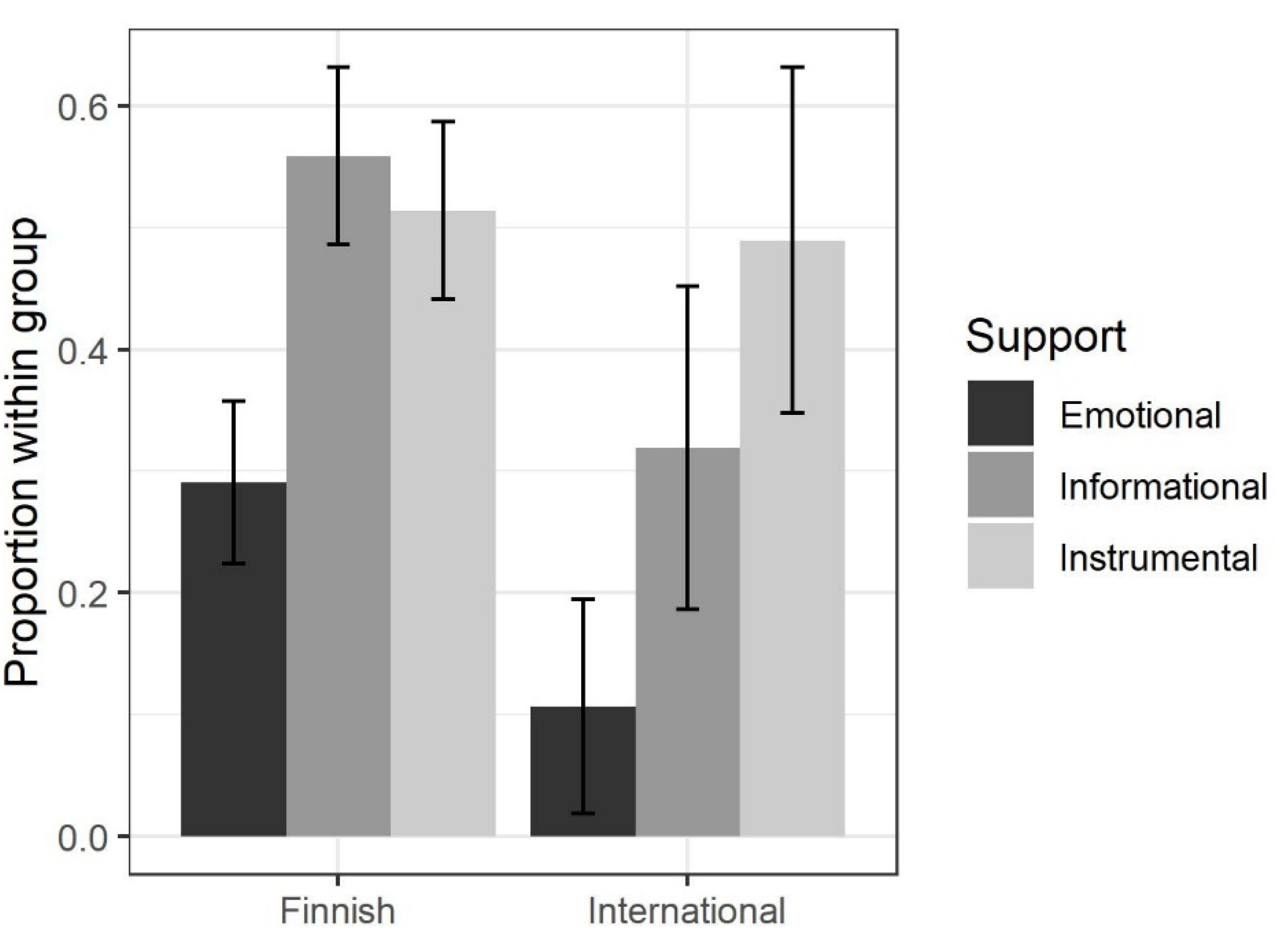
| Model | Classes | LogLik | AIC | AWE | BIC | CAIC | CLC | KIC | SABIC | ICL | Entropy | BLRT | BLRT, p |
|---|---|---|---|---|---|---|---|---|---|---|---|---|---|
| EEI | 2 | −1986.19 | 3986.38 | 4087.19 | 4020.01 | 4027.01 | 3973.83 | 3996.38 | 3997.78 | −4191.39 | 0.73 | 335.68 | 0.01 |
| EEI | 3 | −1931.96 | 3883.92 | 4028.49 | 3931.97 | 3941.97 | 3865.45 | 3896.92 | 3900.21 | −4163.54 | 0.76 | 108.46 | 0.01 |
| EEI | 4 | −1916.49 | 3858.98 | 4047.54 | 3921.44 | 3934.44 | 3834.34 | 3874.98 | 3880.15 | −4330.46 | 0.68 | 30.94 | 0.01 |
| EEI | 5 | −1878.84 | 3789.67 | 4021.84 | 3866.55 | 3882.55 | 3759.25 | 3808.67 | 3815.73 | −4208.50 | 0.79 | 75.31 | 0.01 |
| EEI | 6 | −1900.06 | 3838.12 | 4114.3 | 3929.41 | 3948.41 | 3801.51 | 3860.12 | 3869.07 | −4421.09 | 0.7 | −42.45 | 0.98 |
| EEI | 7 | −1897.98 | 3839.95 | 4159.99 | 3945.66 | 3967.66 | 3797.33 | 3864.95 | 3875.79 | −4511.03 | 0.69 | 4.16 | 0.21 |
| EEI | 8 | −1860.60 | 3771.2 | 4134.9 | 3891.32 | 3916.32 | 3722.73 | 3799.2 | 3811.92 | −4310.98 | 0.76 | 74.76 | 0.01 |
| EEI | 9 | −1859.48 | 3774.96 | 4182.56 | 3909.49 | 3937.49 | 3720.42 | 3805.96 | 3820.57 | −4437.79 | 0.73 | 2.24 | 0.26 |
| VVI | 2 | −1935.29 | 3888.58 | 4018.52 | 3931.83 | 3940.83 | 3872.13 | 3900.58 | 3903.24 | −4070.45 | 0.77 | 437.47 | 0.01 |
| VVI | 3 | −1866.56 | 3761.12 | 3964.2 | 3828.38 | 3842.38 | 3734.57 | 3778.12 | 3783.92 | −4093.05 | 0.73 | 137.46 | 0.01 |
| VVI | 4 | NC | NC | NC | NC | NC | NC | NC | NC | NC | NC | NC | NC |
| VVI | 5 | NC | NC | NC | NC | NC | NC | NC | NC | NC | NC | NC | NC |
| VVI | 6 | NC | NC | NC | NC | NC | NC | NC | NC | NC | NC | NC | NC |
| VVI | 7 | NC | NC | NC | NC | NC | NC | NC | NC | NC | NC | NC | NC |
| VVI | 8 | NC | NC | NC | NC | NC | NC | NC | NC | NC | NC | NC | NC |
| VVI | 9 | NC | NC | NC | NC | NC | NC | NC | NC | NC | NC | NC | NC |
| EEE | 2 | −1942.51 | 3901.03 | 4016.45 | 3939.47 | 3947.47 | 3886.48 | 3912.03 | 3914.06 | −4110.28 | 0.72 | 111.87 | 0.01 |
| EEE | 3 | −1942.68 | 3907.35 | 4067.16 | 3960.2 | 3971.2 | 3886.25 | 3921.35 | 3925.27 | −4640.47 | 0.45 | −0.32 | 0.73 |
| EEE | 4 | −1941.50 | 3910.99 | 4114.73 | 3978.26 | 3992.26 | 3883.79 | 3927.99 | 3933.79 | −4975.53 | 0.4 | 2.36 | 0.1 |
| EEE | 5 | −1895.72 | 3825.44 | 4072.37 | 3907.11 | 3924.11 | 3792.86 | 3845.44 | 3853.12 | −4322.48 | 0.71 | 91.56 | 0.01 |
| EEE | 6 | −1895.02 | 3830.04 | 4120.87 | 3926.13 | 3946.13 | 3791.39 | 3853.04 | 3862.61 | −4457.48 | 0.68 | 1.4 | 0.37 |
| EEE | 7 | −1893.35 | 3832.69 | 4167.36 | 3943.2 | 3966.2 | 3788.04 | 3858.69 | 3870.16 | −4546.15 | 0.67 | 3.34 | 0.35 |
| EEE | 8 | −1859.46 | 3770.91 | 4149.24 | 3895.83 | 3921.83 | 3720.43 | 3799.91 | 3813.26 | −4328.19 | 0.76 | 67.78 | 0.01 |
| EEE | 9 | −1858.26 | 3774.52 | 4196.73 | 3913.86 | 3942.86 | 3717.98 | 3806.52 | 3821.76 | −4440.08 | 0.73 | 2.39 | 0.23 |
| VVV | 2 | −1902.53 | 3827.05 | 3986.43 | 3879.9 | 3890.9 | 3806.38 | 3841.05 | 3844.97 | −4104.12 | 0.66 | 191.84 | 0.01 |
| VVV | 3 | −1853.80 | 3741.61 | 3988.65 | 3823.28 | 3840.28 | 3708.92 | 3761.61 | 3769.29 | −4175.43 | 0.66 | 97.45 | 0.01 |
| VVV | 4 | −1847.55 | 3741.1 | 4075.81 | 3851.61 | 3874.61 | 3696.41 | 3767.1 | 3778.56 | −4325.32 | 0.65 | 12.5 | 0.14 |
| VVV | 5 | −1834.97 | 3727.93 | 4150.31 | 3867.27 | 3896.27 | 3671.23 | 3759.93 | 3775.17 | −4382.59 | 0.65 | 25.17 | 0.01 |
| VVV | 6 | NC | NC | NC | NC | NC | NC | NC | NC | NC | NC | NC | NC |
| VVV | 7 | NC | NC | NC | NC | NC | NC | NC | NC | NC | NC | NC | NC |
| VVV | 8 | NC | NC | NC | NC | NC | NC | NC | NC | NC | NC | NC | NC |
| VVV | 9 | NC | NC | NC | NC | NC | NC | NC | NC | NC | NC | NC | NC |
| Exhausted n = 364 | Exhausted and Cynical n = 373 | No Exhaustion or Cynicism n = 165 | F-Value | p-Value | Effect Size (Generalized Eta Squared) | |
|---|---|---|---|---|---|---|
| Study credits | 48.9 (18.1) | 45.9 (19.8) | 49.1 (17.5) | 2.87(df 2.899) | 0.057 | 0.006 |
| GPA | 3.97 (0.69) | 3.82 (0.76) | 4.15 (0.64) | 12.962 (df 2.874) | <0.001 | 0.029 |
| From Teacher f(%) | From Organisation f(%) | From Support Services f(%) | From the Academic Community f(%) | From Peers f(%) | From Other Sources f(%) | |
|---|---|---|---|---|---|---|
| Informational (f(%) = 39.7%) | 55.5% | 27.3% | 16.3% | 0.6% | 0.3% | - |
| Instrumental (f(%) = 37.7%) | 25.8% | 63% | 1% | - | 0.7% | 9.5% |
| Emotional (f(%) = 21.3%) | 42.2% | 33.7% | 10.2% | 9.6% | 3.6% | - |
| Co-constructional (f(%) = 1.23%) | 50% | - | - | 10% | 40% | - |
| Informational | Instrumental | Emotional | ||||
|---|---|---|---|---|---|---|
| A | B | A | B | A | B | |
| 1 | 111 | 115 | 111 | 115 | 169 | 57 |
| 2 | 89 | 128 | 102 | 115 | 148 | 69 |
| 3 | 51 | 38 | 52 | 37 | 64 | 25 |
Publisher’s Note: MDPI stays neutral with regard to jurisdictional claims in published maps and institutional affiliations. |
© 2022 by the authors. Licensee MDPI, Basel, Switzerland. This article is an open access article distributed under the terms and conditions of the Creative Commons Attribution (CC BY) license (https://creativecommons.org/licenses/by/4.0/).
Share and Cite
Rönkkönen, S.; Mattsson, M.T.; Virtanen, V.; Pyhältö, K.; Inkinen, M. The Nexus between Study Burnout Profiles and Social Support —The Differences between Domestic (Finnish) and International Master’s Degree Students. Behav. Sci. 2022, 12, 79. https://doi.org/10.3390/bs12030079
Rönkkönen S, Mattsson MT, Virtanen V, Pyhältö K, Inkinen M. The Nexus between Study Burnout Profiles and Social Support —The Differences between Domestic (Finnish) and International Master’s Degree Students. Behavioral Sciences. 2022; 12(3):79. https://doi.org/10.3390/bs12030079
Chicago/Turabian StyleRönkkönen, Sara, Markus T. Mattsson, Viivi Virtanen, Kirsi Pyhältö, and Mikko Inkinen. 2022. "The Nexus between Study Burnout Profiles and Social Support —The Differences between Domestic (Finnish) and International Master’s Degree Students" Behavioral Sciences 12, no. 3: 79. https://doi.org/10.3390/bs12030079
APA StyleRönkkönen, S., Mattsson, M. T., Virtanen, V., Pyhältö, K., & Inkinen, M. (2022). The Nexus between Study Burnout Profiles and Social Support —The Differences between Domestic (Finnish) and International Master’s Degree Students. Behavioral Sciences, 12(3), 79. https://doi.org/10.3390/bs12030079






